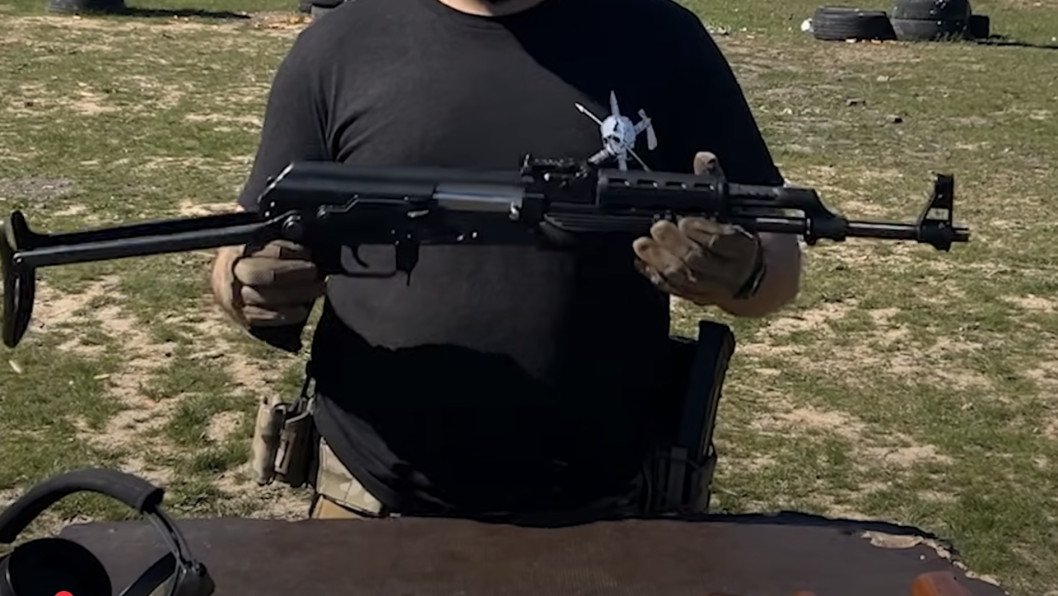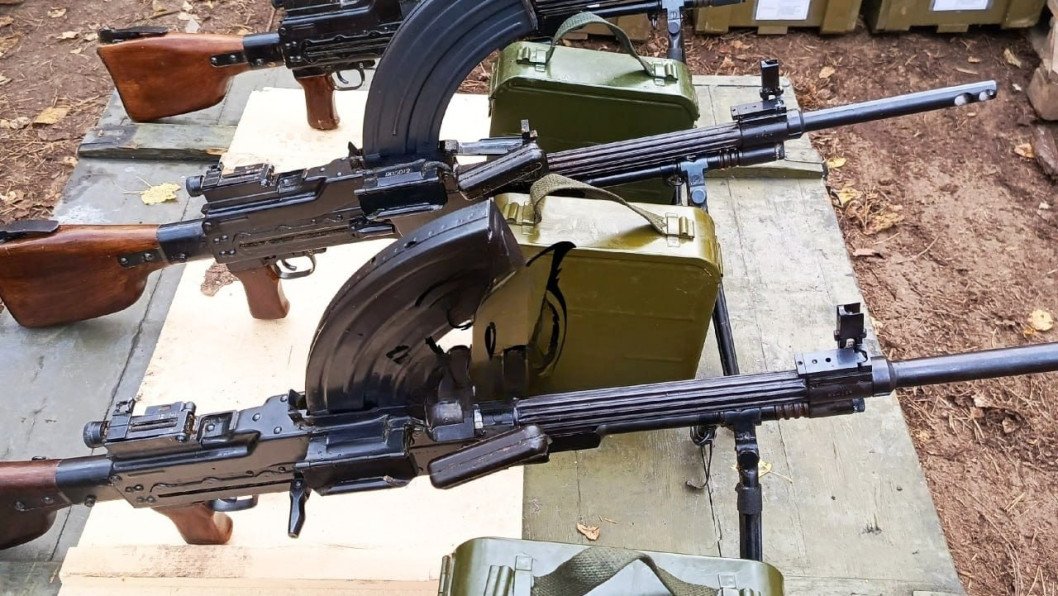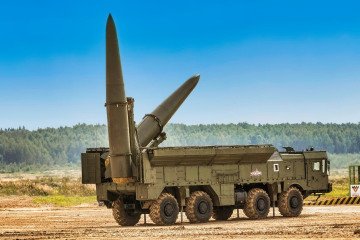Russia sells itself as a military superpower—one of the world’s top arms exporters, with a defense industry built on mass production and legacy firepower. But three years into its full-scale invasion of Ukraine, that image is getting a lot harder to believe.
Alongside drones, thermal scopes, and NATO-standard rifles, some of the weapons appearing in Russia’s war on Ukraine look more suited to a museum than a modern battlefield. Bolt-action rifles from the early 1900s, World War II–era submachine guns, and water-cooled machine guns on wheeled mounts have all turned up in active use, not as relics, but as issued gear.
Some of it comes from Soviet stockpiles, untouched for decades. Some has been funneled in through allies like North Korea and Iran. While both sides have fielded vintage hardware at times, the context couldn’t be more different.
Ukraine, never one to posture as a military superpower, has taken what it can procure—patching, modifying, and repurposing older systems as part of a broader strategy of necessity. It’s a war of survival, and the country has been inventive with what’s available.
Russia claims to be the world’s second most powerful army—a top-tier exporter with global reach and deep reserves. Yet, increasingly, the image doesn’t match the reality. As the war drags on, its troops, particularly those in lower-priority or hastily mobilized units, are being sent to the front with equipment pulled from another era. Here’s a look at some of the most outdated, obscure, and unexpected weapons still showing up on the battlefield, and what their presence reveals about the war behind them.
Pulemyot Maxima 1910 machine gun
Yes, that’s a World War I-era machine gun in the hands of Ukrainian soldiers. The Pulemyot Maxima 1910 machine gun—first produced under Tsar Nicholas II—is a Russian-made copy of Hiram Maxim’s groundbreaking 1880s design, the world’s first fully automatic machine gun.
Only in #Ukraine: A PM M1910/30 Maxim gun with optics, stock, and suppressor. pic.twitter.com/JG1IoPEmfE
— Cᴀʟɪʙʀᴇ Oʙsᴄᴜʀᴀ (@CalibreObscura) March 5, 2023
Though over a century later, it’s been pulled out of storage and put back to work, most notably around Bakhmut. It weighs as much as a small person, runs on water cooling, and still fires the abundant 7.62×54mmR rounds used in modern PKMs.
So why use it? Because it works. The Maxima is water-cooled, meaning it doesn’t overheat like modern air-cooled guns in long engagements. It’s simple to maintain, built like a tank, and takes ammo that's already in circulation. In static defense—like holding a trench or fortifying a strongpoint—it’s more than enough to get the job done.
Also, in typical Ukrainian fashion, some air defense crews have gone a step further—rigging up platforms that mount four Maxim guns side by side, all firing in sync. The setup swivels 360 degrees and can be operated remotely or with basic controls, turning a century-old machine gun into a kind of DIY flak cannon. It’s not sleek, it’s not new, but it absolutely delivers.
Mosin-Nagant rifle
This bolt-action rifle, first issued in 1891, was a cornerstone of both Tsarist and Soviet arsenals—and over a century later, it’s still being carried into battle in Ukraine. The Mosin–Nagant has resurfaced not as a collector’s piece but as a stopgap weapon for Russia’s mobilized troops.
Footage of Russian troops using old Mosin-Nagants in action pic.twitter.com/6COwiNn7Km
— WarRoom Archives (@WarRoomArchives) December 17, 2024
Many of these conscripts, who rushed to the front with minimal training and gear, have been spotted using Mosins in place of standard-issue Kalashnikovs. It's not a coincidence. Russia’s military stockpiles are thinning, and in some meat-wave assaults, the only thing available is whatever’s still functional.
Russian soldiers reportedly stormed Ukrainian positions with Mosin–Nagant rifles in hand in July 2023. Photos from the aftermath confirmed it—at least one soldier, killed in the attack, was carrying the antique firearm.
Chinese Type 56-1 assault rifle
Ukrainian forces patrolling near Toretsk captured a Chinese Type 56-1 assault rifle from a Russian position in March 2025. At first glance, it might look like just another AK, but this one stands out—it's a Chinese-manufactured clone of the original Soviet AK-47, complete with a stamped receiver and an underfolding stock. The Type 56-1 was once a staple of Chinese military exports, showing up in conflicts from Southeast Asia to the Middle East. But its appearance in this war, in near-new condition, raises some real questions.

According to the report by UNITED24 Media, the rifle had clear markings identifying it as Chinese-made and no signs of long-term storage. That detail matters. China has publicly distanced itself from direct military support for Russia, especially since the full-scale invasion. But this rifle suggests the existence of alternative supply routes—possibly via private arms dealers, North Korean intermediaries, or black-market pipelines that don’t officially exist on paper.
It's not the first time Chinese weapons have shown up on the Russian side, but this is one of the clearest indicators that the flow is still active. It’s also a reminder that while sanctions and export controls are one thing, the real-world movement of weapons often slips through the cracks. On a battlefield where logistics are stretched thin, rifles like this one still carry geopolitical weight.
North Korean Type 73 machine gun
The North Korean Type 73 machine gun wasn’t supposed to resurface in modern combat, but here it is, showing up in Russian hands on the battlefield in Ukraine. Designed in the 1970s, the Type 73 is one of Pyongyang’s more obscure weapons. It’s a strange hybrid: it can feed from both 100-round belts and AK-style box magazines, and it fires the 7.62×54mmR cartridge, making it compatible with the same ammo used in Russian PKMs and Dragunovs.

It’s clunky, outdated, and largely phased out even by North Korea. But in a war where Russia is pulling from every corner of its arsenal, it’s back.
UNITED24 Media reported in early 2025 that Ukrainian troops had recovered several Type 73s near Avdiivka, complete with Korean markings. Experts believe these guns were supplied by North Korea, likely funneled through Iran—a route that’s been used before to quietly arm proxy forces.
For context, the Type 73 hasn’t seen front-line use even in North Korea since the 1980s. The fact that Russia is fielding them now speaks volumes about the strain on its logistics—and about how deeply it’s leaning on North Korea and other sanctioned states to keep its war machine running.
The Swedish K
The Swedish K, officially the Carl Gustaf m/45, isn’t the kind of weapon you expect to see in a 21st-century war zone. But in Ukraine, it’s made a quiet return. This 9mm submachine gun was developed by Sweden in the 1940s and became famous for its use by US Navy SEALs during the Vietnam War. It’s simple, durable, and compact—traits that still matter, even in an era dominated by drones and digital targeting.
In early 2024, photos confirmed the weapon’s presence in Ukrainian hands. One image showed a soldier operating a vehicle-mounted Swedish K, its iconic side-mounted magazine visible. It’s unclear whether the weapon was supplied officially through backchannels or brought in privately, but its reappearance says something about how deep Ukraine and its allies are digging to equip territorial and support units.
The Swedish K is no longer standard-issue anywhere, but its reemergence in Ukraine tracks with a broader trend: if it’s reliable, uses common ammo, and still works, it’s getting deployed. Even weapons once considered obsolete are now finding new relevance in this grinding, resource-heavy war.
The Luhansk lot box
In July 2023, a video surfaced from the Luhansk region showing Russian reservists being issued crates of visibly outdated weapons. The footage, shared by NOELREPORTS and covered by Kyiv Post, showed soldiers unpacking pre- and post-WWII small arms in a dusty depot—some dressed in flip-flops and civilian clothes.
The weapons included the PPSh-41, PPS-43, SKS carbines, and even what appeared to be M1 Thompson submachine guns. These were not symbolic displays or training aids—they were reportedly issued for frontline use.
State of the Russian army. The Russian Ministry of Defense has sent a weapons batch to mobilized in the Luhansk region. Weapons such as PPS submachine guns, PPSh-41, SKS Karabin and other pre-WW2 weaponry can be seen🙄 pic.twitter.com/wjLsX928yE
— NOELREPORTS 🇪🇺 🇺🇦 (@NOELreports) July 13, 2023
The PPSh-41, with its iconic drum magazine and high rate of fire, was one of the Red Army’s most widely used weapons during World War II. It fires the 7.62×25mm Tokarev cartridge and was designed for close-quarters fighting in trenches and cities. While effective in its time, it's heavy, loud, and less suited for the precision firefights of modern warfare.
Next to it was the PPS-43, a simpler and more compact wartime successor to the PPSh. Also chambered in 7.62×25mm, the PPS was designed for mass production and ease of use. It lacks the drum magazine of its predecessor and uses a more practical stick mag, but it remains pretty outdated by today’s standards.
The SKS carbine, developed in the late 1940s, was a short-lived Soviet infantry rifle that fired the then-new 7.62×39mm cartridge, later used in the AK-47. With a fixed magazine and no automatic fire capability, it was quickly replaced in service but still saw widespread export during the Cold War.
Finally, the presence of American M1 Thompson submachine guns, which were supplied to the USSR under the WWII Lend-Lease program, caught the attention of many viewers. These American-made .45 caliber guns, once wielded by Allied troops, have now reemerged in Russian hands. Their inclusion in this batch suggests that these crates hadn’t been opened in decades.


-d17bf1e873f867be0e0b457e2de8bf85.jpg)
-c42261175cd1ec4a358bec039722d44f.jpg)
-46f6afa2f66d31ff3df8ea1a8f5524ec.jpg)
-6359eca46c72bde40a90abaaadd6eaa8.png)
-29a1a43aba23f9bb779a1ac8b98d2121.jpeg)


-206008aed5f329e86c52788e3e423f23.jpg)